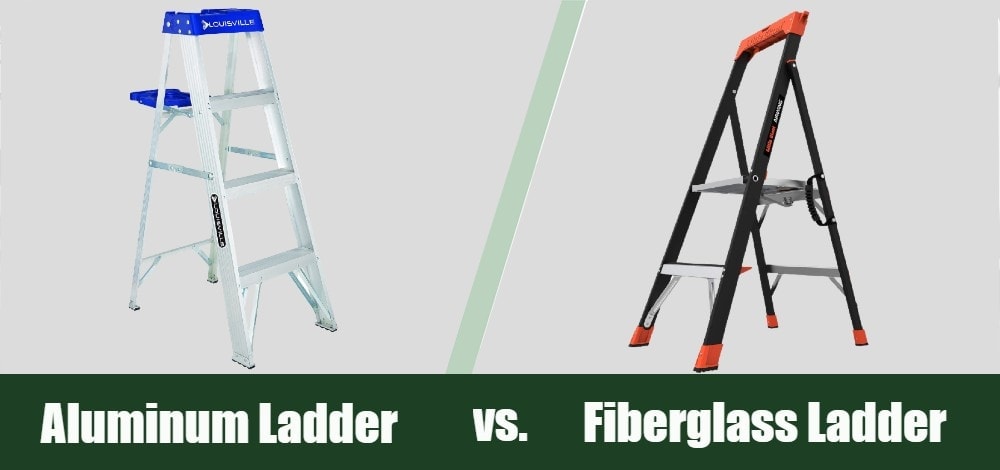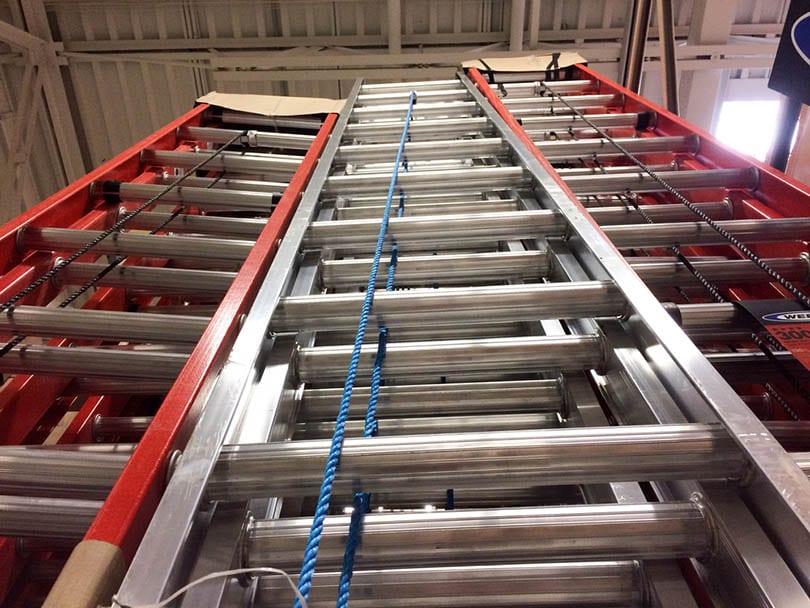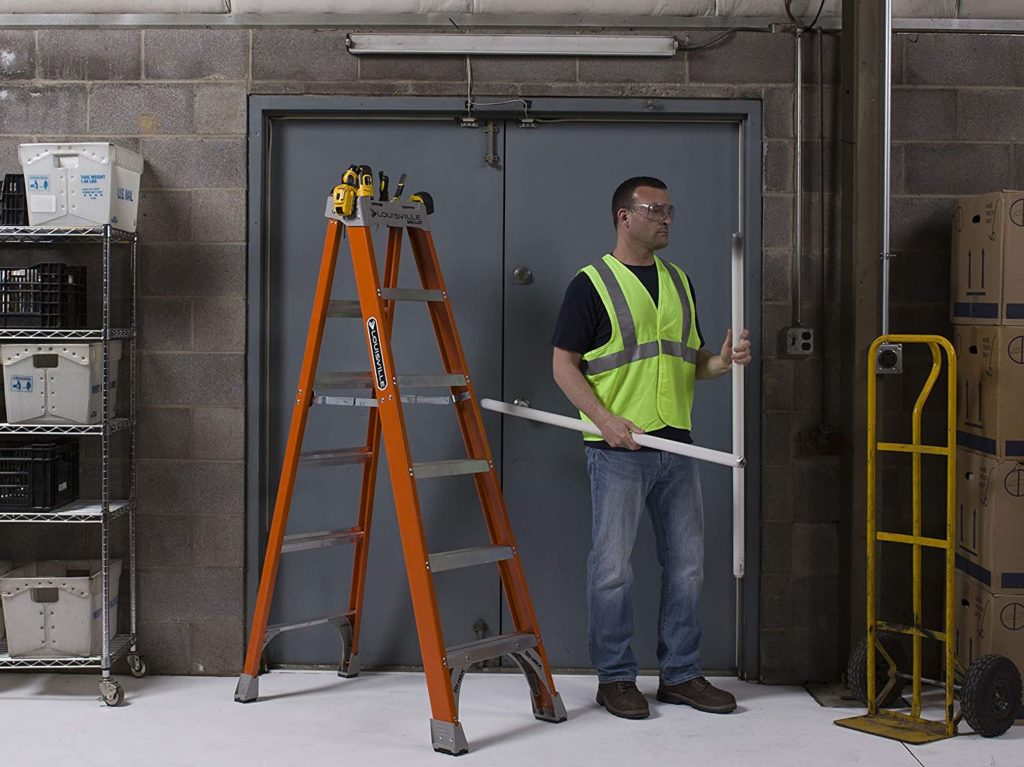Aluminum vs. Fiberglass Ladder: Which Is Better for Your Needs?
-

- Last updated:


Sooner or later, you’re going to need a ladder. A bulb in a ceiling light will go out and make it essential to replace it. Ice dams will form, making cleaning those gutters imperative. After realizing you need it, you must then decide what kind of ladder to get. Aluminum and fiberglass ladders have their pros and cons that are worth considering before you put down the cash.
You’ll find it helpful to think about how you’ll likely use it. For example, if you live in a ranch house or an apartment, you’re not going to need an extension ladder. You should also consider the kinds of projects in which you’d use one so that you’re getting the right tool for the job. Our guide will give you a detailed look at both aluminum and fiberglass ladders to help you make an informed choice.
For the sake of clarity, we’re going to discuss standalone ladders versus ones that you’d use for egress to an attic or boat. These are the products you’d use for DIY projects.
Overview of Aluminum Ladders
The concept of a ladder is a no-brainer, which explains the fact that it’s been around for over 10,000 years. The first ones were made of some type of fiber before wood took on the task. Modern materials like aluminum and fiberglass stepped up to the plate to compensate for the disadvantages of earlier ones with varying degrees of success.
Aluminum is a naturally occurring element that is an element of the Earth’s crust. Materials made from it often use recycled products. Mining is an expensive endeavor since the greatest deposits are overseas in Australia, China, and Guinea. People discovered it early in the 1800s and recognized its desirable qualities that eventually made its way to ladders.
Ease of Use
Aluminum ladders take the forefront because they are lightweight. It’s something you should consider since you’re dealing with items that are large, such as a 6-foot step ladder. They can weigh less than 20 lbs. That’s about what most people can handle easily, despite the size of longer ladders. That’s an excellent selling point if you have to take it from room to room or transport it to a work site.
When to Choose It
As we’ve discussed, weight is a vital consideration, especially if you’re talking about a longer ladder with more material that can make it unwieldy. It’s a critical consideration if you’re taking it through a furnished house or room where you must have control over it to avoid knocking down other objects. It also allows you to tilt it horizontally or vertically, depending on the situation.
Safety
The weight plays a vital role in safety, too. You’re less likely to drop it or use it incorrectly if you can get a decent hold of the ladder. The main concern that may sway you to choose a fiberglass one is aluminum’s ability to conduct electricity. If you’re doing any kind of electrical work, you should consider either a wooden or fiberglass product.
Price Factor
Aluminum gets the nod when it comes to price. These ladders are often cheaper than fiberglass. It’s worth noting that the top three producers of the bauxite needed to manufacture aluminum are Australia, China, and Brazil. However, the chances are that the ladder you buy is made from recycled materials since this metal is so valuable from that perspective. That saves 90% of the energy for new aluminum, making it eco-friendly.
- Lightweight
- Easy maintenance
- Less expensive
- Not suitable for electrical projects
Overview of Fiberglass Ladders
Fiberglass is a manmade product, unlike aluminum, which exists in the Earth’s crust. This material is plastic strengthened with glass fiber, hence, the name. The US Patent Office granted the application for this production method that made this reinforcement possible in 1938. Glass fibers give these ladders their rigid structure that makes them an excellent choice for these products.
Fiberglass ladders offer a durable choice that can last years with proper care. It won’t rot like a wooden ladder left outside and exposed to the elements. Likewise, aluminum is only rust-resistant and can corrode. On the other hand, fiberglass will lose its coating over time because of UV exposure, an issue called fiber bloom. While it’s more of a matter of looks at first, it can lead to the deterioration of the ladder.

Ease of Use
The best thing going for a fiberglass ladder is that it’s reliable and durable. You will feel secure when used correctly. On the downside, these products are heavy. That makes them unwieldy, especially if you have a taller one or an extension ladder. It can make it a safety issue, too, if you’re having problems moving them to the worksite.
When to Choose It
If you need a quality product, a fiberglass ladder is an excellent choice as long as its weight isn’t an issue. You get years of service from it with proper care. That makes it a worthwhile investment if you plan on using it frequently. We suggest looking for a weather-resistant product to help prevent fiber bloom if you do a lot of outdoor work.
Safety
Fiberglass has a few distinct advantages over an aluminum ladder. It is both non-magnetic and non-conductive, making it the safer option for individuals doing electrical work. Interestingly, there are products available that have some aluminum components to cut down on the weight and make them easier to use. The critical thing is that the ladder is stable and steady.
Price Factor
You’ll find fiberglass ladders in a wide range of price points. However, they are typically more expensive than aluminum products. Bear in mind that items with additional materials can cut down the cost and make your purchase more affordable. The other thing to consider is the extra bells and whistles that can make one model more user-friendly than another.
- Safer with projects involving electricity
- Weather-resistant
- Durable
- Expensive
- Heavy
Types of Ladders
There are several types of ladders from which you can choose. Think about the kinds of tasks you typically do to help you select the right one. For example, if you clean out your gutters regularly, you’ll likely find that an extension ladder is the better choice. Another option is to consider a combination one that can do double-duty as a step ladder. Other types you’ll see include:
- Articulating
- Multi-position
- Platform or podium
- Telescoping
- Step stool
You may find that you’ll need more than one type if you have the storage space available.
- Related Read: 4 DIY Boat Ladders You Can Build Today
Other Factors to Consider
Other factors can come into play when you’re comparison shopping. Perhaps, the main ones concern the usability of the ladder by noting its height and weight. Consider who may use it and if it is manageable to handle. We also suggest looking at the open-close mechanism and locking feature. These things are vital to the safety and usability of the product.
Manufacturers typically guarantee their products against defects. We appreciate items that include a warranty. However, more often than not, you’ll find few models that offer this extra coverage. If you’re debating between two ladders, you might find it is a dealmaker if available.
Ladder Design and Construction
While the basic design of a ladder is straightforward, there are some other specs you can check that may make one product more desirable over another. Things you can look for include:
- Number of steps
- Step rise
- Rung type or shape
- Rung material
- Rung depth
A critical spec is the ladder’s duty rating. This term describes the maximum recommended weight. Bear in mind that includes you and your gear. The categories you’ll find include:
- Type I (Heavy Duty), 250 pounds
- Type IA (Extra Heavy Duty), 300 pounds
- Type IAA (Extra Heavy Duty), 375 pounds
- Type II (Medium Duty), 225 pounds
- Type III (Light Duty), 200 pounds
Type 1A is perhaps the most common of the five categories. You’ll find this information with the specs and on the ladder itself.
Other Safety Considerations
Most products will provide additional safety information. Look for ladders that specify that they are both OHSA and ANSI-compliant. OHSA regulates household products, too, so you’ll find this information displayed on the ladder. The American National Standards Institute (ANSI) isn’t a regulatory body, per se. Its mission is to coordinate the regs of other organizations and act as the watchdog for compliance.
Some manufacturers will go the extra mile and conduct third-party testing on top of the other standards. While ANSI and OHSA cover the bases, it does show that the company wants to reassure the consumer on all levels. After all, the concern is valid, considering that there are about 500,000 falls each year, according to the American Academy of Orthopedic Surgeons. About 97% happen at home or the farm.
- Hauling is necessary
- Accessible at higher heights
- Indoor work
- Care against elements
- Near job site
- Lower heights
- Outdoor jobs
- Weather-resistant
Conclusion
The choice between a fiberglass or aluminum ladder balances the need for a safe piece of equipment with usability considerations. The critical parts of this equation are durability and safety. We also suggest thinking about how you plan to use your ladder and who else in your household might need it, too. No matter which one you choose, proper care will make it a worthwhile investment for years to come.
Related Reads:
- Minwax vs. Varathane: Which to Choose?
- Denatured Alcohol vs. Mineral Spirits: Which is Best for Your Needs?
Contents








